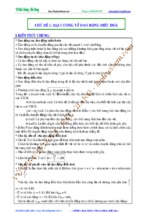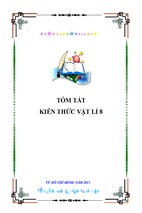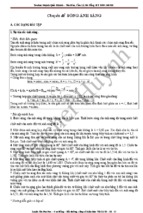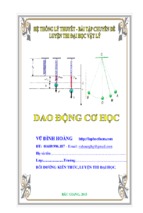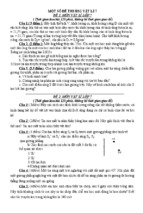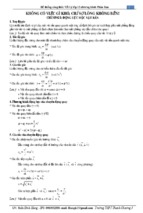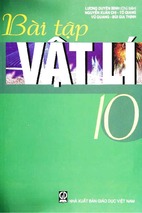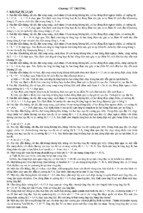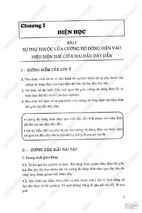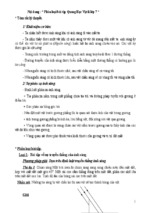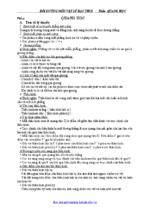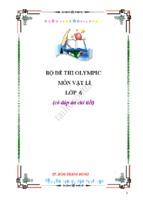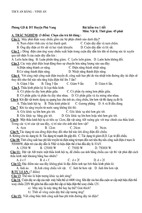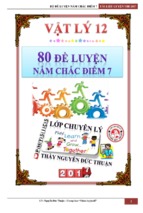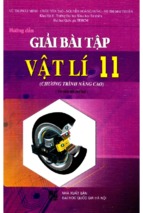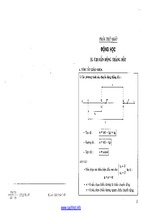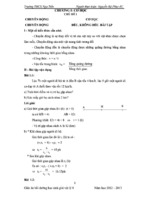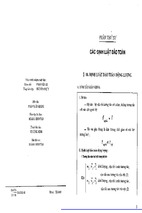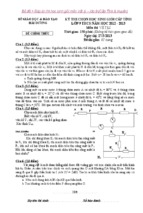Introduction to
STATICS
DYNAMICS
and
Problem Book
Rudra Pratap and Andy Ruina
Spring 2001
c Rudra Pratap and Andy Ruina, 1994-2001. All rights reserved. No part of
°
this book may be reproduced, stored in a retrieval system, or transmitted, in
any form or by any means, electronic, mechanical, photocopying, or otherwise,
without prior written permission of the authors.
This book is a pre-release version of a book in progress for Oxford University
Press.
The following are amongst those who have helped with this book as editors,
artists, advisors, or critics: Alexa Barnes, Joseph Burns, Jason Cortell, Ivan
Dobrianov, Gabor Domokos, Thu Dong, Gail Fish, John Gibson, Saptarsi Haldar, Dave Heimstra, Theresa Howley, Herbert Hui, Michael Marder, Elaina McCartney, Arthur Ogawa, Kalpana Pratap, Richard Rand, Dane Quinn, Phoebus
Rosakis, Les Schaeffer, David Shipman, Jill Startzell, Saskya van Nouhuys, Bill
Zobrist. Mike Coleman worked extensively on the text, wrote many of the examples and homework problems and created many of the figures. David Ho
has brought almost all of the artwork to its present state. Some of the homework problems are modifications from the Cornell’s Theoretical and Applied
Mechanics archives and thus are due to T&AM faculty or their libraries in ways
that we do not know how to give proper attribution. Many unlisted friends,
colleagues, relatives, students, and anonymous reviewers have also made helpful
suggestions.
Software used to prepare this book includes TeXtures, BLUESKY’s implementation of LaTeX, Adobe Illustrator and MATLAB.
Most recent text modifications on January 21, 2001.
Contents
Problems for Chapter 1 .
Problems for Chapter 2 .
Problems for Chapter 3 .
Problems for Chapter 4 .
Problems for Chapter 5 .
Problems for Chapter 6 .
Problems for Chapter 7 .
Problems for Chapter 8 .
Problems for Chapter 9 .
Problems for Chapter 10 .
Problems for Chapter 11 .
Problems for Chapter 12 .
Answers to *’d questions
.
.
.
.
.
.
.
.
.
.
.
.
.
.
.
.
.
.
.
.
.
.
.
.
.
.
.
.
.
.
.
.
.
.
.
.
.
.
.
.
.
.
.
.
.
.
.
.
.
.
.
.
.
.
.
.
.
.
.
.
.
.
.
.
.
.
.
.
.
.
.
.
.
.
.
.
.
.
.
.
.
.
.
.
.
.
.
.
.
.
.
.
.
.
.
.
.
.
.
.
.
.
.
.
.
.
.
.
.
.
.
.
.
.
.
.
.
.
.
.
.
.
.
.
.
.
.
.
.
.
.
.
.
.
.
.
.
.
.
.
.
.
.
.
.
.
.
.
.
.
.
.
.
.
.
.
.
.
.
.
.
.
.
.
.
.
.
.
.
.
.
.
.
.
.
.
.
.
.
.
.
.
.
.
.
.
.
.
.
.
.
.
.
.
.
.
.
.
.
.
.
.
.
.
.
.
.
.
.
.
.
.
.
.
.
.
.
.
.
.
.
.
.
.
.
.
.
.
.
.
.
.
.
.
.
.
.
.
.
.
.
.
.
.
.
.
.
.
.
.
.
.
.
.
.
.
.
.
.
.
.
.
.
.
.
.
.
.
.
.
.
.
.
.
.
.
.
.
.
.
.
.
.
.
.
.
.
.
.
0
.
2
. 10
. 15
. 18
. 31
. 41
. 60
. 74
. 83
. 88
. 100
Problems for Chapter 1
1
Problems for Chapter 1
Introduction to mechanics Because no
mathematical skills have been taught so far, the
questions below just demonstrate the ideas and
vocabulary you should have gained from the
reading.
1.1 What is mechanics?
1.2 Briefly define each of the words below (using rough English, not precise mathematical
language):
a) Statics,
b) Dynamics,
c) Kinematics,
d) Strength of materials,
e) Force,
f) Motion,
g) Linear momentum,
h) Angular momentum,
i) A rigid body.
1.3 This chapter says there are three “pillars”
of mechanics of which the third is ‘Newton’s’
laws, what are the other two?
1.4 This book orgainzes the laws of mechanics
into 4 basic laws numberred 0-III, not the standard ‘Newton’s three laws’. What are these
four laws (in English, no equations needed)?
1.5 Describe, as precisely as possible, a problem that is not mentionned in the book but
which is a mechanics problem. State which
quantities are given and what is to be determined by the mechanics solution.
1.6 Describe an engineering problem which is
not a mechanics problem.
1.7 About how old are Newton’s laws?
1.8 Relativity and quantum mechanics have
overthrown Newton’s laws. Why are engineers
still using them?
1.9 Computation is part of modern engineering.
a) What are the three primary computer
skills you will need for doing problems
in this book?
b) Give examples of each (different thatn
the examples given).
c) (optional) Do an example of each on a
computer.
2
CONTENTS
Problems for Chapter 2
r*BC
B
Vector skills for mechanics
2.1 Vector notation and vector addition
2.11 For the unit vectors λ̂1 and λ̂2 shown
below, find the scalars α and β such that
α λ̂2 − 3λ̂2 = β ˆ .
C
r*CD
y
*
r AB
λ̂2
D
1
k̂
*
2.1 Represent the vector r = 5 mı̂ − 2 mˆ in
three different ways.
2.2 Which one of the following representations
*
of the same vector F is wrong and why?
a)
b)
2N
ˆ
A
ˆ
√
2
d)
13 N
3
problem 2.11:
(Filename:pfigure2.vec1.11)
2.6 The forces acting on a block of mass
m = 5 kg are shown in the figure, where
F1 = 20 N, F2 = 50 N, and W = mg. Find
*
*
*
*
the sum F (= F 1 + F 2 + W )?
√
2.12 In the figure shown, T1 = 20 2 N, T2 =
40 N, and W is such that the sum of the three
forces equals zero. If W is doubled, find α and
*
*
*
β such that α T1 , β T2 , and 2W still sum up to
zero.
*
*
F2
F1
4
√
13 N
2
x
λ̂1
(Filename:pfigure2.vec1.5)
ı̂
c)
1
problem 2.5:
-3 Nı̂ + 2 Nˆ
3N
60o
y
3
T2
4
3
60
3
T1
o
45o
x
*
problem 2.2:
W
(Filename:pfigure2.vec1.2)
problem 2.6:
(Filename:pfigure2.vec1.6)
2.3 There are exactly two representations that
describe the same vector in the following pictures. Match the correct pictures into pairs.
a)
ˆ
b)
4N
4N
o
2.7 Three position vectors are shown in the
*
figure below. Given that rB/A = 3 m( 12 ı̂ +
√
3 ˆ
2 )
*
30
B
30
ˆ
c)
√
2 3N
e)
3 Nı̂ + 1 Nˆ
2 N(-ı̂ +
√
3ˆ)
2.13 In the figure shown, rods AB and BC are
each 4 cm long and lie along y and x axes,
respectively. Rod CD is in the x z plane and
makes an angle θ = 30o with the x-axis.
*
(a) Find rAD in terms of the variable length
`.
d)
2N
(Filename:pfigure2.vec1.12)
*
and rC/B = 1 mı̂ − 2 mˆ , find rA/C .
o
ı̂
W
problem 2.12:
ı̂
(b) Find ` and α such that
r*AD = r*AB − r*BC + α k̂ .
C
f)
z
3 N( 13 ı̂
+ ˆ)
A
D
problem 2.7:
problem 2.3:
(Filename:pfigure2.vec1.7)
(Filename:pfigure2.vec1.3)
*
2.4 Find the sum of forces F1 = 20 Nı̂ −
*
*
2 Nˆ , F2 = 30 N( √1 ı̂ + √1 ˆ ), and F3 =
2
2
√
−20 N(−ı̂ + 3ˆ ).
2.5 In the figure shown below, the position
*
*
vectors are rAB = 3 ftk̂ , rBC = 2 ftˆ , and
*
r*CD = 2 ft(ˆ + k̂ ). Find the position vector
rAD .
*
A
2.8 Given that the sum of four vectors Fi , i =
*
*
1 to 4, is zero, where F1 = 20 Nı̂ , F2 =
*
*
−50 Nˆ , F3 = 10 N(−ı̂ + ˆ ), find F4 .
*
*
2.9 Three forces F = 2 Nı̂ − 5 Nˆ , R =
*
10 N(cos θ ı̂ +sin θ ˆ ) and W = −20 Nˆ , sum
up to zero. Determine the angle θ and draw the
*
force vector R clearly showing its direction.
*
*
2.10 Given that R1 = 1 Nı̂ +1.5 Nˆ and R2 =
*
*
3.2 Nı̂ − 0.4 Nˆ , find 2R1 + 5R2 .
4 cm
30
x
problem 2.13:
`
B
y
o
4 cm
C
(Filename:pfigure2.vec1.13)
*
2.14 Find the magnitudes of the forces F1 =
*
30 Nı̂ −40 Nˆ and F2 = 30 Nı̂ +40 Nˆ . Draw
the two forces, representing them with their
magnitudes.
Problems for Chapter 2
3
*
2.15 Two *
forces R = 2 N(0.16ı̂ +
0.80ˆ ) and W = −36 Nˆ act on a particle.
Find the magnitude of the net force. What is
the direction of this force?
2.21 A 1 m × 1 m square board is supported
by two strings AE and BF. The tension in the
string BF is 20 N. Express this tension as a
vector.
y
2.5 m
2.16 In Problem 2.13, find ` such that the length
*
of the position vector rAD is 6 cm.
y
F
*
E
1
*
(b) the magnitude | rQ/P |.
1
*
*
plate
F2
F1
45o
1m
A
F 2 -F 1
o
D
30
k̂
Q
ˆ
*
2.18 Let two forces P and Q act in the direction shown in the figure. You are allowed to
change the direction of the forces by changing
the angles α and θ while keeping the magniitudes fixed. What should*be the
* values of α
and θ if the magnitude of P + Q has to be the
maximum?
A
x
6"
45o
C
6"
B
O
x
x
problem 2.24:
(Filename:pfigure2.vec1.24)
2.25 Find the unit vector λ̂AB , directed from
point A to point B shown in the figure.
y
y
3m
2m
Q
B
1m A
θ
x
D
D
12"
2.22 The top of an L-shaped bar, shown in the
figure, is to be tied by strings AD and BD to
the points A and B in the yz plane. Find the
length of the strings AD and BD using vectors
r*AD and r*BD .
y
α
Q
ı̂
(Filename:pfigure2.vec1.21)
(Filename:pfigure2.vec1.17)
P
C
problem 2.21:
x
*
B
1m
C
problem 2.17:
P
(a) the relative position vector rQ/P ,
2m
2m
2.17 In the figure shown, F1 = 100 N and
F2 = 300 N. Find the magnitude and direction
*
*
of F2 − F1 .
2.24 A circular disk of radius 6 inis mounted
on axle x-x at the end an L-shaped bar as shown
in the figure. The disk is tipped 45o with the
horizontal bar AC. Two points, P and Q, are
marked on the rim of the plate; P directly parallel to the center C into the page, and Q at the
highest point above the center C. Taking the
base vectors ı̂ , ˆ , and k̂ as shown in the figure,
find
2m
1m
1m
problem 2.18:
(Filename:pfigure2.vec1.18)
A
x
problem 2.25:
(Filename:pfigure2.vec1.25)
2.19 Two points A and B are located in the x y
plane. The coordinates of A and B are (4 mm,
8 mm) and (90 mm, 6 mm), respectively.
*
30o
*
(a) Draw position vectors rA and rB .
*
*
(b) Find the magnitude of rA and rB .
z
y
(Filename:pfigure2.vec1.22)
2.20 In the figure shown, a ball is suspended
with a 0.8 mlong cord from a 2 mlong hoist OA.
*
(a) Find the position vector rB of the ball.
(b) Find the distance of the ball from the
origin.
2.23 A cube of side 6 inis shown in the figure.
*
(a) Find the position vector of point F, rF ,
*
*
*
from the vector sum rF = rD + rC/D +
*
rF/c .
1.5 m
A
2.5 m
1m
*
(b) Calculate | rF |.
*
3m
*
(c) Find rG using rF .
A
z
(Filename:pfigure2.vec1.26)
C
H
G
45o
x
problem 2.20:
A
problem 2.23:
(Filename:pfigure2.vec1.20)
B
problem 2.26:
F
2m
D
B
x
z
y
E
0.8 m
O
2.26 Find a unit vector along string BA and
express the position vector of A with respect to
*
B, rA/B , in terms of the unit vector.
problem 2.22:
(c) How far is A from B?
y
x
B
x
(Filename:pfigure2.vec1.23)
2.27 In the structure shown in the figure, ` =
*
2 ft, h = 1.5 ft. The force in the spring is F =
*
k rAB , where k = 100 lbf/ ft. Find a unit vector
λ̂AB along AB and calculate the spring force
*
F = F λ̂AB .
4
CONTENTS
*
y
2.34 Find the dot product of two vectors F =
10 lbfı̂ −20 lbfˆ and λ̂ = 0.8ı̂ +0.6ˆ . Sketch
*
F and λ̂ and show what their dot product represents.
C
B
*
c2 = a 2 + b2 + 2ab cos θ.
*
*
*
*
*
*
*
(Hint: c = a + b ; also, c · c = c · c )
2.35 The position vector of a point A is rA =
30o
*
30 cmı̂ . Find the dot product of rA with λ̂ =
√
`
h
2.43 Use the dot product to show ‘the law of
cosines’; i. e.,
3
2 ı̂
x
O
problem 2.27:
θ
2.36 From the figure below, find the component
*
of force F in the direction of λ̂.
a
y
(Filename:pfigure2.vec1.27)
b
c
+ 12 ˆ .
problem 2.43:
*
(Filename:pfigure.blue.2.1)
2.28 Express the vector rA = 2 mı̂ − 3 mˆ +
5 mk̂ in terms of its magnitude and a unit vector
indicating its direction.
*
F = 100 N
λ̂
30o
10o
*
2.29 Let F = 10 lbfı̂ + 30 lbfˆ and W =
−20 lbfˆ . Find a unit vector in the direction of
*
*
the net force F + W , and express the the net
force in terms of the unit vector.
2.30 Let λ̂1 = 0.80ı̂ + 0.60ˆ and λ̂2 = 0.5ı̂ +
0.866ˆ .
(a) Show that λ̂1 and λ̂2 are unit vectors.
(b) Is the sum of these two unit vectors also
a unit vector? If not, then find a unit
vector along the sum of λ̂1 and λ̂2 .
2.31 If a mass slides from point A towards point
B along a straight path and the coordinates of
points A and B are (0 in, 5 in, 0 in) and (10 in,
0 in, 10 in), respectively, find the unit vector
λ̂AB directed from A to B along the path.
*
2.32 Write the vectors F1 = 30 Nı̂ + 40 Nˆ −
*
*
10 Nk̂ , F2 = −20 Nˆ + 2 Nk̂ , and F3 =
−10 Nı̂ − 100 Nk̂ as a list of numbers (rows
or columns). Find the sum of the forces using
a computer.
x
problem 2.36:
(Filename:pfigure2.vec1.33)
*
2.37 Find the angle between F1 = 2 Nı̂ +
*
5 Nˆ and F2 = −2 Nı̂ + 6 Nˆ .
*
2.38 A force F is directed from point A(3,2,0)
to point B(0,2,4). If the x-component of the
force is 120 N, find the y- and z-components
*
of F .
2.39 A force acting on a bead of mass m is given
*
as F = −20 lbfı̂ + 22 lbfˆ + 12 lbfk̂ . What is
the angle between the force and the z-axis?
*
2.44 (a) Draw the vector r = 3.5 inı̂ +
3.5 inˆ − 4.95 ink̂ . (b) Find the angle this vector makes with the z-axis. (c) Find the angle
this vector makes with the x-y plane.
2.45 In the figure shown, λ̂ and n̂ are unit vectors parallel and perpendicular to the surface
*
AB, respectively. A force W = −50 Nˆ acts
*
on the block. Find the components of W along
λ̂ and n̂.
A
n̂
ˆ
λ̂
ı̂
W
2.41 The unit normal to a surface is given as
n̂ = 0.74ı̂ + 0.67ˆ . If the weight of a block
on this surface acts in the −ˆ direction, find
the angle that a 1000 N normal force makes
with the direction of weight of the block.
B
O
problem 2.45:
(Filename:pfigure2.vec1.41)
*
*
2.40 Given ω = 2 rad/sı̂ + 3 rad/sˆ , H 1 =
*
ˆ
(20ı̂ +30 ) kg m2 / s and H 2 = (10ı̂ +15ˆ +
*
6k̂ ) kg m2 / s, find (a) the angle between ω and
*
*
*
H 1 and (b) the angle between ω and H 2 .
30o
2.46 From the figure shown, find the compo*
nents of vector rAB (you have to first find this
position vector) along
(a) the y-axis, and
(b) along λ̂.
z
2m
A
2.2 The dot product of two
vectors
2.42 Vector algebra. For each equation below
state whether:
(a) The equation is nonsense. If so, why?
(b) Is always true. Why? Give an example.
(c) Is never true. Why? Give an example.
2.33 Express the unit vectors n̂ and λ̂ in terms
of ı̂ and ˆ shown in the figure. What are the x
*
and y components of r = 3.0 ftn̂ − 1.5 ftλ̂? ∗
(d) Is sometimes true. Give examples both
ways.
*
a) A + B = B + A
ˆ
*
*
*
*
*
c) A · B = B · A
θ
ı̂
*
b) A + b = b + A
n̂
λ̂
* *
d) B /C = B/C
x
problem 2.33:
*
e) b/A = b/A
*
(Filename:efig1.2.27)
* * *
* * *
y
λ̂
x
problem 2.46:
(Filename:pfigure2.vec1.42)
2.47 The net force acting on a particle is F =
2 Nı̂ + 10 Nˆ . Find the components of this
force in another coordinate system with ba0
0
sis vectors ı̂ = − cos θ ı̂ + sin θ ˆ and ˆ =
ˆ
− sin θ ı̂ − cos θ . For θ = 30o, sketch the
*
vector F and show its components in the two
coordinate systems.
*
*
30o
*
You may use trivial examples.
*
y
3m
B
1m
2m
* * *
f) A = (A·B )B +(A·C )C +(A·D )D
2.48 Find the unit vectors ê R and êθ in terms
of ı̂ and ˆ with the geometry shown in figure.
Problems for Chapter 2
5
*
What are the componets of W along ê R and
êθ ?
θ
`
2.54 Write a computer program (or use a
canned program) to find the dot product of
two 3-D vectors. Test the program by computing the dot products ı̂ · ı̂ , ı̂ · ˆ , and ˆ · k̂ .
Now use the program to find the components
*
of F = (2ı̂ + 2ˆ − 3k̂ ) N along the line
r*AB = (0.5ı̂ − 0.2ˆ + 0.1k̂ ) m.
*
2.55 Let rn = 1 m(cos θn ı̂ + sin θn ˆ ), where
θn = θ0 − n1θ . Using a computer generate
the required vectors and find the sum
ˆ
ı̂
W
êR
(Filename:pfigure2.vec1.44)
2.49 Write the position vector of point P in
terms of λ̂1 and λ̂2 and
*
(a) find the y-component of rP ,
*
(b) find the component of rP alon λ̂1 .
a
λ̂2
2
λ̂1
(b)
*
b
60o
a
b
105o
3
4
30o
30o
4
x
problem 2.49:
(Filename:pfigure2.vec1.45)
2.50 What is the distance between the point
A and the diagonal BC of the parallelepiped
shown? (Use vector methods.)
*
*
*
*
* * *
* * *
*
2.58 What is the moment M produced by a 20
N force F acting in the x direction with a lever
*
arm of r = (16 mm)ˆ ?
F = 20 N
45o
b
4
2.60
Find
*
* the sum of moments of forces
W and T about the origin, given that W =
100 N, T = 120 N, ` = 4 m, and θ = 30o .
y
*
45o
b
O
(f)
`/2
`/2
x
*
W
θ
x
problem 2.60:
y
(Filename:pfigure2.vec2.3)
*
b
3
2.61 Find the moment of the force
3
3
2
x
problem 2.59:
a
5
*
3
O
T
45o
x
*
2m
2
3
*
x
2
a
*
a
2
a) about point A
x
b) about point O.
F = 50 N
4
problem 2.50:
(Filename:pfigure.blue.2.3)
*
(g)
*
b = 4ˆ
y
*
2.51 Let F1 = 30 Nı̂ + 40 Nˆ − 10 Nk̂ , F2 =
*
−20 Nˆ + 2 Nk̂ , and F3 = F3x ı̂ + F3 y ˆ −
F3z k̂ . If the sum of all these forces must equal
zero, find the required scalar equations to solve
*
for the components of F3 .
2.52 A vector equation for the sum of forces
results into the following equation:
√
F
R
(ı̂ − 3ˆ ) + (3ı̂ + 6ˆ ) = 25 Nλ̂
2
5
where λ̂ = 0.30ı̂ − 0.954ˆ . Find the scalar
equations parallel and perpendicular to λ̂.
*
*
d) A ×(B × C ) = (A · C )B −(A · B )C
y
a
(e) y
b
1
x
(d)
4
C
*
*
*
*
*
θ1
A
*
(Filename:pfigure2.vec2.2)
y
4
(c) y
B
*
y
x
`1
*
*
c) C · (A × B ) = B · (C × A)
2.56 Find the cross product of the two vectors
shown in the figures below from the information given in the figures.
*
θ2
*
*
b) B × C = C · B
2.3 Cross product, moment,
and moment about an axis
(a) y
P
`2
*
n=0
problem 2.48:
y
*
2.59 Find the moment of the force shown on
the rod about point O.
44
X
r*i , with 1θ = 1o and θ0 = 45o .
êθ
*
*
a) B × C = C × B
*
*
*
2.53 Let α F1 + β F2 + γ F3 = 0 , where
* *
*
F1 , F2 , and F3 are as given in Problem 2.32.
Solve for α, β, and γ using a computer.
(h)
α = 30o
y
(-1,2)
*
*
b
(2,2)
a
x
*
a=
3ı̂ +
ˆ
1.5 m
x
(-1,-1)
(2,-1)
problem 2.56:
O
(Filename:pfigure2.vec2.1)
2.57 Vector algebra. For each equation below
state whether:
(a) The equation is nonsense. If so, why?
(b) Is always true. Why? Give an example.
(c) Is never true. Why? Give an example.
(d) Is sometimes true. Give examples both
ways.
You may use trivial examples.
2m
A
problem 2.61:
(Filename:pfigure2.vec2.4)
2.62 In the figure shown, OA = AB = 2 m. The
force F = 40 N acts perpendicular to the arm
*
AB. Find the moment of F about O, given that
*
θ = 45o . If F always acts normal to the arm
AB, would increasing θ increase the magnitude
of the moment? In particular, what value of θ
will give the largest moment?
6
CONTENTS
y
F
θ
2.66 Find the sum of moments due to the
two weights of the teeter-totter when the teetertotter is tipped at an angle θ from its vertical
position. Give your answer in terms of the variables shown in the figure.
B
`
A
A
`
`
O
α α
θh
O
2.63 Calculate the moment of the 2 kNpayload
on the robot arm about (i) joint A, and (ii) joint
B, if `1 = 0.8 m, `2 = 0.4 m, and `3 = 0.1 m.
y
W
B
4"
C
x
C
5"
B
problem 2.73:
W
(Filename:efig1.2.11)
(Filename:pfigure2.vec2.9)
C
2 kN
x
problem 2.63:
(Filename:pfigure2.vec2.6)
2.67 Find the percentage error in computing
*
the moment of W about the pivot point O as
a function of θ , if the weight is assumed to act
normal to the arm OA (a good approximation
when θ is very small).
2.64 During a slam-dunk, a basketball player
pulls on the hoop with a 250 lbf at point C of the
ring as shown in the figure. Find the moment
of the force about
a) the point of the ring attachment to the
board (point B), and
O
`
*
2.74 If the magnitude of a force N normal
to the surface ABCD in the figure is 1000 N,
*
write N as a vector. ∗
z
B
A
A
θ
1m
W
x
problem 2.67:
1m
C
D
1m
1m
6"
1.5'
3' B
10'
2.69 Why did the chicken cross the road? ∗
basketball hoop
15o
250 lbf
2.70 Carry out the following cross products in
different ways and determine which method
takes the least amount of time for you.
*
*
a) r = 2.0 ftı̂ + 3.0 ftˆ − 1.5 ftk̂ ; F =
*
*
−0.3 lbfı̂ − 1.0 lbfk̂ ; r × F =?
*
O
*
b) r = (−ı̂ + 2.0ˆ + 0.4k̂ ) m; L =
*
*
(3.5ˆ − 2.0k̂ ) kg m/s; r × L =?
problem 2.64:
(Filename:pfigure2.vec2.7)
2.65 During weight training, an athelete pulls
a weight of 500 Nwith his arms pulling on a
hadlebar connected to a universal machine by
a cable. Find the moment of the force about the
shoulder joint O in the configuration shown.
problem 2.65:
(Filename:pfigure2.vec2.8)
y
(Filename:efig1.2.12)
2.68 What do you get when you cross a vector
and a scalar? ∗
board
1m
problem 2.74:
(Filename:pfigure2.vec2.10)
b) the root of the pole, point O.
A
y
5"
problem 2.66:
`2
45o
A
D
OA = h
AB = AC = `
`3
30o
`1
z
`
(Filename:pfigure2.vec2.5)
A
2.73 Find a unit vector normal to the surface
ABCD shown in the figure.
B
x
problem 2.62:
O
%program definition
z(1)=a(1)*b(1);
z(2)=a(2)*b(2);
z(3)=a(3)*b(3);
w=z(1)+z(2)+z(3);
*
2.75 The equation of a surface is given as z =
2x − y. Find a unit vector n̂ normal to the
surface.
2.76 In the figure, a triangular plate ACB, attached to rod AB, rotates about the z-axis. At
the instant shown, the plate makes an angle of
60o with the x-axis. Find and draw a vector
normal to the surface ACB.
z
B
*
c) ω = (ı̂ − 1.5ˆ ) rad/s; r = (10ı̂ −
*
*
2ˆ + 3k̂ ) in; ω × r =?
45o
*
2.71 A force F = 20 Nˆ − 5 Nk̂ acts through
a point A with coordinates (200 mm, 300 mm,
*
*
*
-100 mm). What is the moment M (= r × F )
of the force about the origin?
2.72 Cross Product program Write a program
that will calculate cross products. The input to
the function should be the components of the
two vectors and the output should be the components of the cross product. As a model, here
is a function file that calculates dot products in
pseudo code.
C
45o
A
x
1m
y
60o
problem 2.76:
(Filename:efig1.2.14)
2.77 What is the distance d between the origin
and the line AB shown? (You may write your
*
*
solution in terms of A and B before doing any
∗
arithmetic).
Problems for Chapter 2
7
*
z
A
1
k̂
ı̂
*
d
*
*
1
y
4
*
B
*
f) What is r D O × F 1 ? ( r D O ≡ r O/D
is the position of O relative to D.) ∗
(3, 2, 5)
1
(0, 7, 4)
*
*
B
1
B
x
problem 2.77:
(Filename:pfigure.blue.1.3)
2.78 What is the perpendicular distance between the point A and the line BC shown?
(There are at least 3 ways to do this using various vector products, how many ways can you
find?)
y
B
A
g) What is the moment of F 2 about the
axis DC? (The moment of a force about
an axis parallel to the unit vector λ̂ is
* *
*
defined as Mλ = λ̂·( r ×F ) where r is
the position of the point of application
of the force relative to some point on
the axis. The result does not depend
on which point on the axis is used or
*
which point on the line of action of F
is used.). ∗
h) Repeat the last problem using either a
different reference point on the axis DC
or the line of action OB. Does the solution agree? [Hint: it should.] ∗
D
2
4
3
5
C
A
x
(5, 2, 1)
7
(3, 4, 1)
y
problem 2.83:
(Filename:pfigure.s95q2)
2.4 Equivalant force systems and couples
z
ˆ
A
5m
C
ı̂
z
5
e) What is the component of F 1 in the
x-direction? ∗
O
3
c) What are the coordinates of the point
on the plane closest to point D? ∗
d) What is the angle AOB? ∗
*
A
ˆ
*
c) Write both F 1 and F 2 as the product
of their magnitudes and unit vectors in
their directions. ∗
0
x
3
2
B
2.84 Find the net force on the particle shown
in the figure.
6N
F2
problem 2.78:
(Filename:pfigure.blue.2.2)
*
2.79 Given a force, F 1 = (−3ı̂ + 2ˆ + 5k̂ ) N
acting at a point P whose position is given by
r*P/O = (4ı̂ − 2ˆ + 7k̂ ) m, what is the moment about an axis through the origin O with
direction λ̂ = √2 ˆ + √1 ˆ ?
5
a) Make a neat sketch of the vectors OA,
OB, and AB.
b) Find a unit vector in the direction of
OA, call it λ̂ O A .
*
c) Find the force F which is 5N in size
and is in the direction of OA.
d) What is the angle between OA and OB?
*
e) What is r B O × F ?
*
f) What is the moment of F about a line
parallel to the z axis that goes through
the point B?
4
F1
3m
D
x
ı̂
problem 2.81:
(Filename:p1sp92)
8N
2.82 A, B, and C are located by position
*
*
vectors r A = (1, 2, 3), r B = (4, 5, 6), and
r*C = (7, 8, 9).
problem 2.84:
(Filename:pfigure2.3.rp1)
a) Use the vector dot product to find the
angle B AC (A is at the vertex of this
angle).
b) Use the vector cross product to find the
angle BC A (C is at the vertex of this
angle).
2.85 Replace the forces acting on the particle of mass m shown in the figure by a single
equivalent force.
2T
c) Find a unit vector perpendicular to the
plane ABC.
d) How far is the infinite line defined by
AB from the origin? (That is, how close
is the closest point on this line to the
origin?)
e) Is the origin co-planar with the points
A, B, and C?
T
T
45
o
30
o
m
ˆ
mg
ı̂
problem 2.85:
2.83 Points A, B, and C in the figure define a
plane.
a) Find a unit vector in the direction OB.
a) Find a unit normal vector to the plane.
b) Find a unit vector in the direction OA.
b) Find the distance from this infinite
plane to the point D. ∗
∗
10 N
ˆ
C
2.81 Vector Calculations and Geometry.
*
The 5 N force F 1 is along the line OA. The
*
7 N force F 2 is along the line OB.
∗
P
3
y
4m
5
2.80 Drawing vectors and computing with
vectors. The point O is the origin. Point A has
x yz coordinates (0, 5, 12)m. Point B has x yz
coordinates (4, 5, 12)m.
*
O
(Filename:pfigure2.3.rp2)
∗
2.86 Find the net force on the pulley due to the
belt tensions shown in the figure.
8
CONTENTS
2.90 The forces and the moment acting on point
C of the frame ABC shown in the figure are
C x = 48 N, C y = 40 N, and Mc = 20 N·m.
Find an equivalent force couple system at point
B.
30o
50 N
A
20 cm
Cy
B
ˆ
C
50 N
Cx
30 cm
1.2 m
ı̂
MC
B
MC
(Filename:pfigure2.3.rp10)
(Filename:pfigure2.3.rp3)
1.5 m
2.87 Replace the forces shown on the rectangular plate by a single equivalent force. Where
should this equivalent force act on the plate and
why?
300 mm
2.5 Center of mass and center of gravity
A
problem 2.90:
A
(Filename:pfigure2.3.rp7)
D
200 mm
B
C
2.91 Find an equivalent force-couple system
for the forces acting on the beam in Fig. ??, if
the equivalent system is to act at
a) point B,
4N
5N
b) point D.
problem 2.87:
(Filename:pfigure2.3.rp4)
2.88 Three forces act on a Z-section ABCDE as
shown in the figure. Point C lies in the middle
of the vertical section BD. Find an equivalent
force-couple system acting on the structure and
make a sketch to show where it acts.
2 kN
A
B
D
C
2m
1 kN
A
C
0.6 m
2 kN
problem 2.91:
B
(Filename:pfigure2.3.rp8)
40 N
100 N
D
0.5 m
E
problem 2.88:
(Filename:pfigure2.3.rp5)
2.92 In Fig. ??, three different force-couple
systems are shown acting on a square plate.
Identify which force-couple systems are equivalent.
30 N
30 N
2.89 The three forces acting on the circular
plate shown in the figure are equidistant from
the center C. Find an equivalent force-couple
system acting at point C.
3
2F
40 N
6 N·m
0.2 m
20 N
30 N
0.2 m
20 N
30 N
2.94 An otherwise massless structure is made
of four point masses, m, 2m, 3m and 4m, located at coordinates (0, 1 m), (1 m, 1 m), (1 m,
−1 m), and (0, −1 m), respectively. Locate the
center of mass of the structure. ∗
2.95 3-D: The following data is given for
a structural system modeled with five point
masses in 3-D-space:
mass
0.4 kg
0.4 kg
0.4 kg
0.4 kg
1.0 kg
coordinates (in m)
(1,0,0)
(1,1,0)
(2,1,0)
(2,0,0)
(1.5,1.5,3)
Locate the center of mass of the system.
2m
0.5 m
60 N
10 N
problem 2.93:
problem 2.86:
6N
C
20 N
2.96 Write a computer program to find the center of mass of a point-mass-system. The input
to the program should be a table (or matrix)
containing individual masses and their coordinates. (It is possible to write a single program
for both 2-D and 3-D cases, write separate programs for the two cases if that is easier for
you.) Check your program on Problems 2.94
and 2.95.
2.97 Find the center of mass of the following
composite bars. Each composite shape is made
of two or more uniform bars of length 0.2 m and
mass 0.5 kg.
(a)
(b)
problem 2.92:
(Filename:pfigure2.3.rp9)
C
F
R
F
problem 2.89:
(Filename:pfigure2.3.rp6)
2.93 The force and moment acting at point C
of a machine part are shown in the figure where
Mc is not known. It is found that if the given
force-couple system is replaced by a single horizontal force of magnitude 10 N acting at point
A then the net effect on the machine part is the
same. What is the magnitude of the moment
Mc ?
(c)
problem 2.97:
(Filename:pfigure3.cm.rp7)
Problems for Chapter 2
9
2.98 Find the center of mass of the following two objects [Hint: set up and evaluate the
needed integrals.]
y
(a)
m = 2 kg
r = 0.5 m
x
O
y
(b)
m = 2 kg
r = 0.5 m
O
x
problem 2.98:
(Filename:pfigure3.cm.rp8)
2.99 Find the center of mass of the following
plates obtained from cutting out a small section from a uniform circular plate of mass 1 kg
(prior to removing the cutout) and radius 1/4 m.
(a)
200 mm x 200 mm
(b)
r = 100 mm
100 mm
problem 2.99:
(Filename:pfigure3.cm.rp9)
10
CONTENTS
Problems for Chapter 3
x
F = 50 N
Free body diagrams
3.1 Free body diagrams
h
y
a) the statics force balance and moment
balance equations?
b) the dynamics linear momentum balance
and angular momentum balance equations?
A
L
frictionless
3.1 How does one know what forces and moments to use in
G
problem 3.4:
3.5 A 1000 kg satellite is in orbit. Its speed is v
and its distance from the center of the earth is R.
Draw a free body diagram of the satellite. Draw
another that takes account of the slight drag
force of the earth’s atmosphere on the satellite.
v*
m
R
problem 3.8:
(Filename:ch2.6)
3.9 A uniform rod of mass m rests in the back
of a flatbed truck as shown in the figure. Draw
a free body diagram of the rod, setP
up a suitable
*
F for the
coordinate system, and evaluate
rod.
frictionless
5a
C
A
ˆ
B
B
θ
(Filename:pfig2.2.rp1)
3.2 A point mass m is attached to a piston
by two inextensible cables. There is gravity.
Draw a free body diagram of the mass with a
little bit of the cables.
9a
x
m = 10 kg
3.8 A thin rod of mass m rests against a frictionless wall and on a frictionless floor. There
is gravity. Draw a free body diagram of the
rod.
m
6a
G
problem 3.5:
ı̂
(Filename:pfigure.s94h2p5)
problem 3.9:
problem 3.2:
(Filename:pfigure2.1.suspended.mass)
3.6 The uniform rigid rod shown in the figure
hangs in the vertical plane with the support of
the spring shown. Draw a free body diagram
of the rod.
`/3
3.3 Simple pendulum. For the simple pendulum shown the “body”— the system of interest
— is the mass and a little bit of the string. Draw
a free body diagram of the system.
k
m
(Filename:pfig2.2.rp5)
3.10 A disc of mass m sits in a wedge shaped
groove. There is gravity and negligible friction.
The groove that the disk sits in is part of an
assembly that is still. Draw a free body diagram
of the disk. (See also problems 4.15 and 6.47.)
`
r
problem 3.6:
(Filename:pfig2.1.rp1)
θ
L
3.7 FBD of rigid body pendulum. The rigid
body pendulum in the figure is a uniform rod
of mass m. Draw a free body diagram of the
rod.
y
θ1
θ2
x
problem 3.10:
(Filename:ch2.5)
problem 3.3:
g
θ
(Filename:pfigure.s94h2p1)
3.4 Draw a free body diagram of mass m at
the instant shown in the figure. Evaluate the
left hand side
momentum balance
P of
* the linear
*
equation ( F = m a ) as explicitly as possible. Identify the unknowns in the expression.
`
uniform rigid
bar, mass m
problem 3.7:
(Filename:pfigure2.rod.pend.fbd)
3.11 A pendulum, made up of a mass m attached at the end of a rigid massless rod of
length `, hangs in the vertical plane from a
hinge. The pendulum is attached to a spring
and a dashpot on each side at a point `/4 from
the hinge point. Draw a free body diagram
of the pendulum (mass and rod system) when
the pendulum is slightly away from the vertical
equilibrium position.
Problems for Chapter 3
11
3.15 A small block of mass m slides down an
incline with coefficient of friction µ. At an
instant in time t during the motion, the block
has speed v. Draw a free body diagram of the
block.
1/4 `
k
c
k
c
3/4 `
2b
b
C
D
d
P
E
2d
G
m
A
µ
m
B
problem 3.18:
(Filename:ch2.2)
problem 3.11:
α
(Filename:pfig2.1.rp5)
problem 3.15:
3.12 The left hand side of the angular momentum balance (Torque balance in statics) equation requires the evaluation of the sum of moments about some point. Draw a free body diagramPof the rod shown in the figure and com*
MO as explicitly as possible. Now
pute
P *
compute
M C . How many unknown forces
does each equation contain?
(Filename:pfig2.3.rp5)
3.16 Assume that the wheel shown in the figure rolls without slipping. Draw a P
free body
*
F and
diagram of the wheel and evaluate
P *
MC . What would be different in the expressions obtained if the wheel were slipping?
3.19 A spring-mass model of a mechanical
system consists of a mass connected to three
springs and a dashpot as shown in the figure.
The wheels against the wall are in tracks (not
shown) that do not let the wheels lift off the wall
so the mass is constrained to move only in the
vertical direction. Draw a free body diagram
of the system.
m
1
L/2
m = 5 kg
3
C
O
r C
R
F = 10 N
c
k
k
k
m = 20 kg
problem 3.19:
L
P
problem 3.12:
(Filename:pfig2.1.rp2)
problem 3.16:
(Filename:pfig2.2.rp3)
3.13 A block of mass m is sitting on a frictionless surface at points A and B and acted upon
at point E by the force P. There is gravity.
Draw a free body diagram of the block.
2b
C
b
D
d
(Filename:pfig2.2.rp4)
3.17 A compound wheel with inner radius r
and outer radius R is pulled to the right by
a 10 N force applied through a string wound
around the inner wheel. Assume that the wheel
rolls to the right without slipping. Draw a free
body diagram of the wheel.
F = 10 N
P
E
A
r
B
C
(See also problem 5.32.)
R
problem 3.13:
(Filename:ch2.1)
a) Draw a free body diagram of the of the
mass and spring together at the instant
of interest.
b) Draw free body diagrams of the mass
and spring separately at the instant of
interest.
2d
G
3.20 A point mass of mass m moves on a frictionless surface and is connected to a spring
with constant k and unstretched length `. There
is gravity. At the instant of interest, the mass
has just been released at a distance x to the
right from its position where the spring is unstretched.
P
m = 20 kg
`
m
problem 3.17:
3.14 A mass-spring system sits on a conveyer
belt. The spring is fixed to the wall on one
end. The belt moves to the right at a constant
speed v0 . The coefficient of friction between
the mass and the belt is µ. Draw a free body
diagram of the mass assuming it is moving to
the left at the time of interest.
k
m
µ
problem 3.14:
(Filename:pfig2.1.rp6)
x
(Filename:pfig2.1.rp8)
problem 3.20:
(Filename:ch2.10)
3.18 A block of mass m is sitting on a frictional surface and acted upon at point E by the
horizontal force P through the center of mass.
The block is resting on sharp edge at point B
and is supported by a small ideal wheel at point
A. There is gravity. Draw a free body diagram
of the block including the wheel, assuming the
block is sliding to the right with coefficient of
friction µ at point B.
3.21 FBD of a block. The block of mass 10 kg
is pulled by an inextensible cable over the pulley.
a) Assuming the block remains on the
floor, draw a free diagram of the block.
b) Draw a free body diagram of the pulley
and a little bit of the cable that rides
over it.
12
CONTENTS
x
F = 50 N
x
m = 10 kg
h
y
3.25 In the system shown, assume that the two
masses A and B move together (i.e., no relative
slip). Draw a free body diagram of mass A and
evaluate the left hand side of the linear momentum balance equation. Repeat the procedure
for the system consisting of both masses.
g
frictionless
ı̂
A
µ = 0.2
rigid,
massless
problem 3.21:
m
k
(Filename:pfigure2.1.block.pulley)
B
3.22 A pair of falling masses. Two masses A
& B are spinning around each other and falling
towards the ground. A string, which you can
assume to be taught, connects the two masses.
A snapshot of the system is shown in the figure.
Draw free body diagrams of
a) mass A with a little bit of string,
b) mass B with a little bit of string, and
c) the whole system.
B
`
θ
ˆ
F
problem 3.25:
(Filename:pfig2.2.rp2)
3.26 Two identical rigid rods are connected
together by a pin. The vertical stiffness of the
system is modeled by three springs as shown
in the figure. Draw free body diagrams of each
rod separately. [This problem is a little tricky
and there is more than one reasonable answer.]
m
problem 3.28:
(Filename:pfigure2.simp.pend.fbd)
3.29 For the double
P *pendulum
P *shown in the figF and MO at the instant
ure, evaluate
shown in terms of the given quantities and unknown forces (if any) on the bar.
O
`
θ1
m
massless
m
30o
k
k
2k
θ2
`
m
A
problem 3.26:
problem 3.29:
m
(Filename:pfig2.1.rp3)
(Filename:pfig2.2.rp6)
3.27 A uniform rod rests on a cart which is
being pulled to the right. The rod is hinged at
one end (with a frictionless hinge) and has no
friction at the contact with the cart. The cart
rolls on massless wheels that have no bearing
friction (ideal massless wheels). Draw FBD’s
of
3.30 See also problem 11.4. Two frictionless
blocks sit stacked on a frictionless surface. A
force F is applied to the top block. There is
gravity.
problem 3.22:
(Filename:pfigure.s94h2p4)
3.23 A two-degree of freedom spring-mass
system is shown in the figure. Draw free body
diagrams of each mass separately and then the
two masses together.
x1
k1
x2
k4
k2
a) the rod,
g
b) the cart, and
m1
m1
F
c) the whole system.
m2
k3
a) Draw a free body diagram of the two
blocks together and a free body diagram
of each block separately.
A
m2
θ
problem 3.23:
(Filename:pfig2.1.rp4)
3.24 The figure shows a spring-mass model of
a structure. Assume that the three masses are
displaced to the right by x1 , x2 and x3 from the
static equilibrium configuration such that x1 <
diagrams of each
x2 < x3 . Draw free
Pbody
*
mass and evaluate
F in each case. Ignore
gravity.
x1
k5
m
k3
k1
M
x3
x2
k4
m
k6
k2
B
F
problem 3.30:
(Filename:ch2.3)
problem 3.27:
(Filename:pfigure.s94h2p6)
3.28 FBD’s of simple pendulum and its parts.
The simple pendulum in the figure is composed
of a rod of negligible mass and a pendulum bob
of mass m.
a) Draw a free body diagram of the pendulum bob.
3.31 For the system shown in the figure draw
free body diagrams of each mass separately
assuming that there is no relative slip between
the two masses.
A
k
µ = 0.2
F
B
b) Draw a free body diagram of the rod.
problem 3.24:
(Filename:pfig2.2.rp10)
c) Draw a free body diagram of the rod
and pendulum bob together.
problem 3.31:
(Filename:pfig2.1.rp7)
Problems for Chapter 3
13
3.32 Two frictionless prisms of similar right
triangular sections are placed on a frictionless
horizontal plane. The top prism weighs W and
the lower one, nW . Draw free body diagrams
of
b
3.35 An imagined testing machine consists of
a box fastened to a wheel as shown. The box
always moves so that its floor is parallel to the
ground (like an empty car on a Ferris Wheel).
Two identical masses, A and B are connected
together by cords 1 and 2 as shown. The floor of
the box is frictionless. The machine and blocks
are set in motion when θ = 0o , with constant
θ̇ = 3 rad/s. Draw free body diagrams of:
φ
a) the system consisting of the box,
blocks, and wheel,
a) the system of prisms and
b) each prism separately.
W
b) the system of box and blocks,
c) the system of blocks and cords,
nW
d) the system of box, block B, cord 2, and
a portion of cord 1 and,
φ
e) the box and blocks separately.
a
z
B
D
C
1m
1m
y
3m
A
x
4m
4m
problem 3.37:
(Filename:pfigure2.1.3D.pulley.fbd)
3.38 Mass on inclined plane. A block of
mass m rests on a frictionless inclined plane.
It is supported by two stretched springs. The
mass is pulled down the plane by an amount
δ and released. Draw a FBD of the mass just
after it is released.
problem 3.32:
pivot
A
(Filename:pfigure.blue.28.2)
1
3.33 In the slider crank mechanism shown,
draw a free
body diagram
P*
P * of the crank and
F and MO as explicitly as posevaluate
sible.
Crank of
mass m
ω
B
2
θ̇
1m
θ
k
1m
massless
m
δ
o
30
θ
2m
k
problem 3.35:
2m
(Filename:pfigure.blue.52.1)
problem 3.33:
(Filename:pfig2.2.rp9)
3.34 FBD of an arm throwing a ball. An
arm throws a ball up. A crude model of an arm
is that it is made of four rigid bodies (shoulder, upper arm, forearm and a hand) that are
connected with hinges. At each hinge there are
muscles that apply torques between the links.
Draw a FBD of
a) the ball, the shoulder (fixed to the wall),
b) the upper arm,
c) the fore-arm,
3.36 Free body diagrams of a double ‘physical’ pendulum. A double pendulum is a system where one pendulum hangs from another.
Draw free body diagrams of various subsystems in a typical configuration.
a) Draw a free body diagram of the lower
stick, the upper stick, and both sticks in
arbitrary configurations.
b) Repeat part (a) but use the simplifying
assumption that the upper bar has negligible mass.
problem 3.38:
(Filename:efig2.1.24)
3.39 Hanging a shelf. A shelf with negligible
mass supports a 0.5 kgmass at its center. The
shelf is supported at one corner with a ball and
socket joint and the other three corners with
strings. At the moment of interest the shelf is
in a rocket in outer space and accelerating at
10 m/s2 in the k direction. The shelf is in the
x y plane. Draw a FBD of the shelf.
G
d) the hand, and
e) the whole arm (all four parts) including
the ball.
Write the equation of angular momentum balance about the shoulder joint A, evaluating the
left-hand-side as explicitly as possible.
A
C
B 32m
O
φ1
H
`
.48m E
1m
1m
φ2
A
`
problem 3.39:
1m
k̂
D
ı̂
ˆ
(Filename:ch3.14)
problem 3.36:
(Filename:pfigure.s94h2p3)
B
C
D
problem 3.34:
(Filename:efig2.1.23)
3.37 The strings hold up the mass m = 3 kg.
There is gravity. Draw a free body diagram of
the mass.
3.40 A massless triangular plate rests against
a frictionless wall at point D and is rigidly attached to a massless rod supported by two ideal
bearings. A ball of mass m is fixed to the centroid of the plate. There is gravity. Draw a free
body diagram of the plate, ball, and rod as a
system.
14
CONTENTS
d
d=c+(1/2)b
y
D
z
e h
G
B
a
b
A
x
c
problem 3.40:
(Filename:ch2.9)
3.41 An undriven massless disc rests on its
edge on a frictional surface and is attached
rigidly by a weld at point C to the end of a
rod that pivots at its other end about a ball-andsocket joint at point O. There is gravity.
a) Draw a free body diagram of the disk
and rod together.
b) Draw free body diagrams of the disc
and rod separately.
c) What would be different in the free
body diagram of the rod if the ball-andsocket was rusty (not ideal)?
ω
ball and
socket
z
L
O
R
C
y
weld
x
problem 3.41:
(Filename:ch2.7)
Problems for Chapter 4
15
Problems for Chapter 4
4.4 What force should be applied to the end of
the string over the pulley at C so that the mass
at A is at rest?
Statics
4.1 Static equilibrium of one
body
P
*
*
4.1 To evaluate the equation
F = m a for
P*
some problem, a student writes
F = Fx ı̂ −
(Fy − 30 N)ˆ + 50 Nk̂ in the x yz coordinate
*
0
0
system, but a = 2.5 m/s2 ı̂ + 1.8 m/s2 ˆ −
0
x 0 y0 z0
az k̂ in a rotated
coordinate system. If
ı̂ 0 = cos 60o ı̂ + sin 60o ˆ , ˆ 0 = − sin 60o ı̂ +
ˆ
g
ı̂
F
4.2 N small blocks each of mass m hang vertically as shown, connected by N inextensible
strings. Find the tension Tn in string n. ∗
m
n=1
n=2
m
B
n=N-2
n=N-1
=0
2F3 = 0.
A
m
2m
3m
problem 4.4:
(Filename:f92h1p1.a)
4.2 Elementary truss analysis
The first set of problems concerns math skills
that can be used to help solve truss problems.
If computer solution is not going to be used,
the following problems can be skipped.
1
x − 2y + π z − 11 = 0.
3
m
√
4m
3m
2x − 3y + 5 = 0,
y + 2π z = 21,
n=4
b) 2F1 +
3F
2 2
Can the student solve for F1 , F2 , and F3
uniquely from these equations? ∗
C
4.5 Write the following equations in matrix
form to solve for x, y, and z:
n=3
m
2
c) 52 F2 +
0
cos 60o ˆ and k̂ = k̂ , find the scalar equations
for the x 0 , y 0 , and z 0 directions.
a) F1 − 12 F2 + √1 F3 = 0
4.9 What is the solution to the set of equations:
x
x
x
x
+y+z+w
−y+z−w
+y−z−w
+y+z−w
=
=
=
=
0
0
0
2?
4.3 Advanced truss analysis: determinacy, rigidity,
and redundancy
4.4 Internal forces
4.5 Springs
m
n=N
4.6 Are the following equations linearly independent?
m
problem 4.2:
(Filename:pfigure2.hanging.masses)
4.3 See also problem 7.98. A zero length
spring (relaxed length `0 = 0) with stiffness
k = 5 N/m supports the pendulum shown. Assume g = 10 N/ m. Find θ for static equilibrium. ∗
`0 = 0
k = 5 N/m
D=4m
y
m = 2 kg
θ
4.7 Write computer commands (or a program)
to solve for x, y and z from the following equations with r as an input variable. Your program
should display an error message if, for a particular r , the equations are not linearly independent.
4.10 What is the stiffness of two springs in parallel?
4.11 What is the stiffness of two springs in series?
a) 5x + 2r y + z = 2
g = 10 m/s
x
a) x1 + 2x2 + x3 = 30
b) 3x1 + 6x2 + 9x3 = 4.5
c) 2x1 + 4x2 + 15x3 = 7.5.
L=3m
problem 4.3:
(Filename:pfigure2.blue.80.2.a)
b) 3x + 6y + (2r − 1)z = 3
c) 2x + (r − 1)y + 3r z = 5.
Find the solutions for r = 3, 4.99, and 5.
4.12 What is the apparant stiffness of a pendulum when pushed sideways.
4.8 An exam problem in statics has three unknown forces. A student writes the following
three equations (he knows that he needs three
equations for three unknowns!) — one for the
force balance in the x-direction and the other
two for the moment balance about two different
points.
4.13 Optimize a triangular truss for stiffness
and for strength and show that the resulting
design is not the same.
16
CONTENTS
4.6 Structures and machines
4.14 See also problems 6.18 and 6.19. Find
the ratio of the masses m 1 and m 2 so that the
system is at rest.
m1
g
A
B
m2
30o
60o
problem 4.14:
(Filename:pulley4.c)
4.15 (See also problem 6.47.) What are the
forces on the disk due to the groove? Define
any variables you need.
d) Another
look at equilibrium. [Harder] Draw
a careful sketch and find a point where
the lines of action of the gravity force
and string tension intersect. For the reel
to be in static equilibrium, the line of action of the reaction force at C must pass
through this point. Using this information, what must the tangent of the angle
φ of the reaction force at C be, measured with respect to the normal to the
slope? Does this answer agree with that
you would obtain from your answer in
part(c)? ∗
e) What is the relationship between the angle ψ of the reaction at C, measured
with respect to the normal to the ground,
and the mass ratio required for static
equilibrium of the reel? ∗
m
M
Check that for θ = 0, your solution gives
=
*
0 and F C = Mg ˆ and for θ = π2 , it gives
*
m
ˆ
M = 2 and F C = Mg(ı̂ + 2 ).
M
r
g
y
θ1
x
ˆ
(Filename:ch2.5.b)
massless
R
r
G
P
ˆ
C
ı̂
θ
m
problem 4.18:
(Filename:pfigure2.blue.47.3.b)
4.19 Two racks connected by three gears at
rest. See also problem 7.86. A 100 lbf force
is applied to one rack. At the output, the machinery (not shown) applies a force of FB to
the other rack. Assume the gear-train is at rest.
What is FB ?
y
massless
rack
massless
A
FB = ?
B
x
RA
b C
RC
d E RE
P
R
r
θ2
problem 4.15:
M
g
no slip
100 lb
C
ı̂
no slip
massless
rack
G
m
θ
problem 4.19: Two racks connected by
three gears.
(Filename:ch4.5.a)
4.16 Two gears at rest. See also problems 7.77
and ??. At the input to a gear box, a 100 lbf
force is applied to gear A. At the output, the
machinery (not shown) applies a force of FB
to the output gear. Assume the system of gears
is at rest. What is FB ?
no slip
RA
RC C
FB = ?
RB
B
A
FA = 100 lb
problem 4.16: Two gears.
(Filename:pg131.3.a)
4.17 See also problem 4.18. A reel of mass M
and outer radius R is connected by a horizontal
string from point P across a pulley to a hanging
object of mass m. The inner cylinder of the
reel has radius r = 12 R. The slope has angle θ .
There is no slip between the reel and the slope.
There is gravity.
a) Find the ratio of the masses so that the
system is at rest. ∗
b) Find the corresponding tension in the
string, in terms of M, g, R, and θ. ∗
c) Find the corresponding force on the reel
at its point of contact with the slope,
point C, in terms of M, g, R, and θ . ∗
problem 4.17:
(Filename:pfigure2.blue.47.3.a)
4.18 This problem is identical to problem 4.17
except for the location of the connection point
of the string to the reel, point P. A reel of
mass M and outer radius R is connected by
an inextensible string from point P across a
pulley to a hanging object of mass m. The inner
cylinder of the reel has radius r = 12 R. The
slope has angle θ. There is no slip between the
reel and the slope. There is gravity. In terms
of M, m, R, and θ, find:
a) the ratio of the masses so that the system
is at rest, ∗
b) the corresponding tension in the string,
and ∗
4.20 In the flyball governor shown, the mass
of each ball is m = 5 kg, and the length of
each link is ` = 0.25 m. There are frictionless hinges at points A, B, C, D, E, F where
the links are connected. The central collar
has mass m/4. Assuming that the spring of
constant k = 500 N/m is uncompressed when
θ = π radians, what is the compression of the
spring?
m/4
B
m
A
`
`
`
θ
F
`
m
k
E
θ
`
D
`
C
fixed
problem 4.20:
(Filename:summer95p2.2.a)
c) the corresponding force on the reel at its
point of contact with the slope, point C.
∗
Check that for θ = 0, your solution gives
*
m
Mg ˆ and for θ = π2 ,
M = 0 and F C = *
m
it gives M = −2 and F C = Mg(ı̂ − 2ˆ ).The
negative mass ratio is impossible since mass
cannot be negative and the negative normal
force is impossible unless the wall or the reel or
both can ‘suck’ or they can ‘stick’ to each other
(that is, provide some sort of suction, adhesion,
or magnetic attraction).
4.21 Assume a massless pulley is round and
has outer radius R2 . It slides on a shaft that
has radius Ri . Assume there is friction between the shaft and the pulley with coefficient
of friction µ, and friction angle φ defined by
µ = tan(φ). Assume the two ends of the line
that are wrapped around the pulley are parallel.
a) What is the relation between the two
tensions when the pulley is turning?
You may assume that the bearing shaft
touches the hole in the pulley at only
one point. ∗ .
Problems for Chapter 4
17
b) Plug in some reasonable numbers for
Ri , Ro and µ (or φ) to see one reason why wheels (say pulleys) are such
a good idea even when the bearings are
not all that well lubricated. ∗
c) (optional) To further emphasize the
point look at the relation between the
two string tensions when the bearing is
locked (frozen, welded) and the string
slides on the pulley with same coefficient of friction µ (see, for example,
Beer and Johnston Statics section 8.10).
Look at the force ratios from parts (a)
and (b) for a reasonable value of µ, say
µ = 0.2. ∗
ˆ
FBD
(a)
winch
(b)
winch
B
C
3m
A z
m
m
x
O
Ri
4m
A
2m 3m
(c)
z
winch
winch
B
D 1m
1m
y
C winch
3m
A
x
4m
4m
problem 4.23:
(Filename:f92h1p1)
ı̂
Ro
B
T1
Forces of bearing
on pulley
4.24 The strings hold up the mass m = 3 kg.
You may assume the local gravitational constant is g = 10 m/s2 . Find the tensions in the
strings if the mass is at rest.
z
T2
B
D
C
problem 4.21:
(Filename:pfigure.blue.20.2)
4.22 A massless triangular plate rests against
a frictionless wall at point D and is rigidly attached to a massless rod supported by two ideal
bearings fixed to the floor. A ball of mass m
is fixed to the centroid of the plate. There is
gravity and the system is at rest What is the
reaction at point D on the plate?
d
d=c+(1/2)b
e h
G
3m
A
x
4m
4m
problem 4.24:
(Filename:f92h1p1.b)
a) Draw a FBD of the shelf.
B
a
A
y
4.25 Hanging a shelf. A uniform 5 kg shelf is
supported at one corner with a ball and socket
joint and the other three corners with strings.
At the moment of interest the shelf is at rest.
Gravity acts in the−k̂ direction. The shelf is
in the x y plane.
y
D
z
1m
1m
b
x
c
problem 4.22:
(Filename:ch3.1b)
4.7 Hydrostatics
4.8 Advanced statics
4.23 See also problem 5.119. For the three
cases (a), (b), and (c), below, find the tension
in the string AB. In all cases the strings hold up
the mass m = 3 kg. You may assume the local
gravitational constant is g = 10 m/s2 . In all
cases the winches are pulling in the string so
that the velocity of the mass is a constant 4 m/s
upwards (in the k̂ direction). [ Note that in
problems (b) and (c), in order to pull the mass
up at constant rate the winches must pull in the
strings at an unsteady speed.] ∗
b) Challenge: without doing any calculations on paper can you find one of the
reaction force components or the tension in any of the cables? Give yourself
a few minutes of staring to try to find
this force. If you can’t, then come back
to this question after you have done all
the calculations.
c) Write down the equation of force equilibrium.
d) Write down the moment balance equation using the center of mass as a reference point.
e) By taking components, turn (b) and
(c) into six scalar equations in six unknowns.
f) Solve these equations by hand or on the
computer.
g) Instead of using a system of equations
try to find a single equation which can
be solved for TE H . Solve it and compare to your result from before. ∗
h) Challenge: For how many of the reactions can you find one equation which
will tell you that particular reaction
without knowing any of the other reactions? [Hint, try moment balance about
various axes as well as aforce balance in
an appropriate direction. It is possible
to find five of the six unknown reaction
components this way.] Must these solutions agree with (d)? Do they?
G
A
C
.48m E
1m
1m
problem 4.25:
32m
B
H
1m
k̂
D
ı̂
ˆ
(Filename:pfigure.s94h2p10.a)
- Xem thêm -

